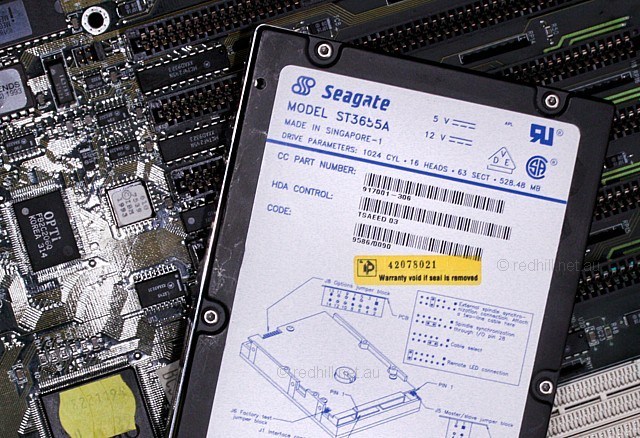
Photo: Red Hill.
Seagate Medalist 3655 family
A plain, ugly exterior for a very interesting drive indeed.
Up until about 1990, you could classify drives into two broad types according to head count. Drives with an even number of heads positioned over the desired track "blind" by stepping the arm in or out a certain number of times. This was cheap, fairly slow, and not especially reliable. In particular, it was vulnerable to thermal expansion and contraction problems throwing the head-track alignment out. In contrast, drives with an odd number of heads typically used a voice coil actuator and positioned the head stack by making an initial guess and then reading calibration data encoded on the "extra" surface and micro-adjusting as required. This was significantly faster and more reliable because it made them largely immune to thermal expansion problems, but cost more — not least because it required the "waste" of one side of a whole platter.
All that changed with the development of embedded servo drives, where the positioning information is added to a normal data surface allowing the drive to use a fast, reliable voice coil actuator but avoid the "waste" of a data surface. Conner pioneered this revolutionary technique in the late 1980s and by about 1991 it had become standard practice for mainstream drives.
A dwindling handful of cheap, slow IDE drives still used the old stepper technology; examples were the half-decent little Seagate ST351A/X and the quite dreadful Kalok Octagon KL3100 which was still manufactured until about 1993. Exotic cost-no-object SCSI drives retained the traditional dedicated servo head design for years longer — presumably for performance reasons — and with it the trademark odd number of heads. In something like a Seagate Elite 9 (27 heads) or a Micropolis 2217 (15 heads) the sacrifice of a single data surface was unimportant. But these were exceptions: mainstream IDE drives all used embedded servo by this time.
This brings us, at last, to the Seagate ST3655 family — standard-looking IDE drives but using dedicated servo heads and an odd number of data surfaces like a SCSI drive: very unusual. The spindle speed was 4500 RPM — quite uncommon at that time when most drives were somewhere between 3200 and 3900 RPM — and the cache was a then-gigantic 256k. The 528MB capacity of the largest model was unusual too, and the 12ms seek time, while not outlandish, was more than respectable. In short, under the skin this ugly, unimpressive-looking drive was more like an enterprise-class SCSI drive: by the IDE standards of the day, very large, very fast, and presumably very expensive. We never saw them new, and I don't remember seeing more than one or two examples even second-hand.
| Performance | 0.72 | Reliability | no data |
| Data rate | 36.56 Mbit/sec | Spin rate | 4500 RPM |
| Seek time | 12ms | Buffer | 256k |
| Platter capacity | 210MB | Interface | IDE |
| ST3390A | 341.3MB | 3 heads | |
| ST3550A | 452.4MB | 5 heads | |
| ST3655A | 528.5MB | 5 heads |